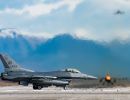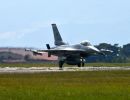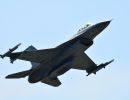But at Aviano Air Base, Italy, this isn’t anything new. It’s there, at the foot of the Dolomite Mountains, where you’ll find the 31st Air Expeditionary Wing, the first such unit in Europe.
Activated in May, the 31st AEW puts airmen supporting Operation Joint Forge, Bosnia’s peacekeeping mission, under a single chain of command. Previously, NATO’s Combined Air Operations Center in Vicenza, Italy, would call various squadrons at Aviano when assigning combat missions over Bosnia-Herzegovina. Now, the center goes to the 31st AEW, a system more in line with the Air Force’s one-base, one-boss philosophy.
News was made in August when Air Force leaders announced that the service would transition to an expeditionary aerospace force within 18 months. By January 2000, Gen. Michael Ryan, Air Force chief of staff, said we will have the mindset, procedures, doctrine and organization to allow for the most effective use of people and resources for challenges resulting from the post-Cold War era.
But at Aviano Air Base, Italy, this isn’t anything new. It’s there, at the foot of the Dolomite Mountains, where you’ll find the 31st Air Expeditionary Wing, the first such unit in Europe.
Activated in May, the 31st AEW puts airmen supporting Operation Joint Forge, Bosnia’s peacekeeping mission, under a single chain of command. Previously, NATO’s Combined Air Operations Center in Vicenza, Italy, would call various squadrons at Aviano when assigning combat missions over Bosnia-Herzegovina. Now, the center goes to the 31st AEW, a system more in line with the Air Force’s one-base, one-boss philosophy.
Under an expeditionary concept, there are two distinct blueprints. One is a U.S.-based AEW – a quick-response force tailored to project decisive, short-term air power. The other, an in-place AEW at established bases, supports long-term contingencies. Overlaid onto permanent organizations, such as Aviano’s 31st Fighter Wing, in-place AEWs deliver sustained air power without exhausting host units’ resources.
“When we deploy aircraft to supplement the 31st AEW, it’s usually in small packages because Aviano already has housing, messing and security forces,” said Lt. Gen. Michael C. Short, 16th Air Force commander. “All we need to supply is aircraft, aircrews and support people to plus-up what’s already there.”
To deal with Bosnia operations, Short said Aviano, the only U.S. fighter base permanently assigned to NATO’s southern region, was given a dual role. While the 31st FW brings the majority of the firepower to the fight, the 31st AEW’s sole responsibility is to support NATO combat air operations over the former Yugoslavia, where 250,000 people died during a bloody four-year civil war. All airmen deployed to Aviano are part of the AEW as well as many of those permanently assigned to the 31st Fighter Wing.
Aviano pilots from the 510th and 555th Fighter Squadrons rotate flying both missions using F-16 Fighting Falcons, which are loaded with precision-guided bombs and air-to-air missiles during Joint Forge sorties.
Two distinct jobs
The difference between the two missions is clear.
“You can have two four-ship formations leaving side by side,” the general noted. “Four of the birds have practice missiles, and their pilots aren’t wearing survival vests. The other four aircraft down the ramp have live munitions, and their pilots, wearing survival vests, are in a contingency mindset because they’re going in harm’s way.”
What’s Aviano’s gain from pulling essentially double duty? A sense of accomplishment, a sense of purpose, said Brig. Gen. Timothy A. Peppe, 31st AEW and 31st FW commander.
“We know that our presence has helped stabilize things [in Bosnia],” Peppe said. “We know, as opposed to four or five years ago, large numbers of people are not getting annihilated left and right.”
Plus, 31st FW airmen receive multinational training and get a glimpse of tomorrow’s Air Force – an expeditionary aerospace force.
“On our Bosnia runs, we get to work with tactical air control parties, the guys on the ground who guide us to targets, from NATO and non-NATO countries,” said Col. Jeffrey W. Eberhart, 31st Operations Group commander. “We practice with them on close-air-support strikes, which is why we’re here. It’s what we would do if SFOR troops had a major confrontation.
“And anytime we would deploy anywhere else for another mission,” he added, “it would not be solely as the 31st FW. It’s going to be a coordinated effort with a bunch of different types of airplanes – E-3s, EC-130s and other kinds of fighters – that would comprise an AEW package. That’s a definite advantage we enjoy here daily.”
Eberhart described the diverse NATO and U.S. aircraft 31st FW and 31st AEW aircrews interact with during exercises and real-world missions. They include: British E-3 Sentry airborne warning and control systems, French Jaguars, Italian Tornadoes, Spanish EF-18s, F-16s from Portugal, Turkey, Denmark and Belgium, Guard KC-135s, Marine AV-8s and Navy EA-6B’s.
All were used this summer for Operation Determined Falcon, an aerial show of force over the Balkans. Eighty aircraft from 13 countries participated in the one-day exercise meant to halt violence in Kosovo, a small province south of Yugoslavia. Forming a 120-mile airflow from the Adriatic Sea to Albania and Macedonia, coalition warplanes practiced air-to-air, air-to-ground and suppression-of-aerial-defense maneuvers.
Short, who is also commander of Allied Air Forces Southern Europe, called the exercise “a vivid demonstration of NATO’s ability to rapidly project power into the region.”
“This is what air power is all about,” he said. “The inherent speed and flexibility to get it where it needs to be in a hurry, in a very short time.”
They also are inherent in the expeditionary force concept. So is relying on host-nation cooperation. For example, Italy’s support of Aviano and the 31st AEW. Short said some people “don’t stop and think” what Italy has done to help Balkan operations.
“We have been at it for years,” he said, referring to Aviano sorties flown into Bosnia. “There has been noise overhead. Aircraft constantly flying over nearby communities. Base facilities being used heavily by other nations. And through it all, Italy has been a superb host.”
Ryan, who directed NATO air combat operations in Bosnia before becoming chief of staff, added: “Whether it’s shaping the international environment, responding to conflict or preparing for a more secure tomorrow, we must have the capability and trust to work together toward a more stable and peaceful world. For it is when peace and stability fail that our air forces will be called on, and expected to be first to respond, first to fight and first to win.”
Sounds like an expeditionary aerospace force.













































